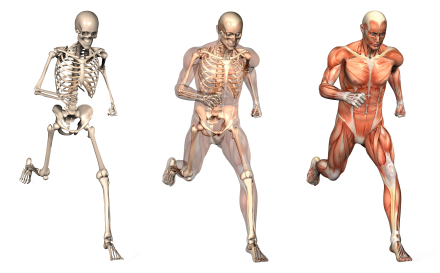 So have you ever had sore knees or a tender low back from running? If not now, there is a chance that you eventually will, either from too much of it or from bad technique.
So have you ever had sore knees or a tender low back from running? If not now, there is a chance that you eventually will, either from too much of it or from bad technique.
Many people will enter a fitness facility and tend to gravitate towards the aerobic equipment like treadmills. There is nothing inherently “wrong” with using these pieces of equipment, but allow me to shed more light on this.
Why do we use these machines? Most people use it for a fat reduction technique by reaching particular heart rates (both high and low) to break down triglycerides (aka fat) as a primary fuel source. Sounds reasonable right?
In small doses, I would tend to agree. However, many people tend to run about 30-45 minutes at a time. Up to 3 times or more a week. This leads me into a concept of overuse.
We hear about this term a lot from the workforce. We hear it from people who may type too often who develop carpel tunnel syndrome, or from manual laborers who lift too much weight too often, with incorrect form. How is it, then, that running is different? I don’t think that it is.
When you run, it is not uncommon to plant your feet a couple thousand times over a period of 30-60 minutes of cardio. Moreover, the force that is driven up through your body each time your foot hits the ground can be 2-4 times your bodyweight (1) That certainly is a lot of repetition and force. And it is not uncommon to hear people who run a lot to have bad ankles, knees, hips and low backs.
There are better aerobic and anaerobic alternatives that create the same metabolic effect as running: resistance exercise.
Most people associate resistance training as a method of developing strength, power, agility and speed. And they are correct. However, the thing to remember is that weights are tools, and they will yield different outcomes depending on how they are handled.
People burn more fat when their heart rates are higher than at rest. This is done through manipulating speed and time as mentioned earlier. In order to create the same effect through resistance exercise, you need to make the repetitions a little higher (say 15-20) with little to no rest between sets. This will keep the heart rate up, like when running, or any other type of cardio that we typically see in the gym.
Secondly, it is a great idea to pair up exercises together that works different groups of muscle (aka push and pull approach), and then jump back and forth between sets. (i.e., pushups and chin ups). You can have as many exercises placed in a “circuit” as you want. Ideally, by the end of the session, it would be great to have spread the weight training throughout the entire body. The idea is little to no rest. This is somewhat of a rudimentary explanation but I am sure you get the idea.
The most important point to draw from this article is that a circuit approach with higher repetitions with little rest between sets will:
1. Dramatically decrease the time you spend in the gym
2. Spread the movements through many joints over the body instead of a few
3. Create much less force and wear on joints
4. Reduce stress hormones like cortisol (which tends to break down muscle and deposit fat on the abdomen region)
5. Burn fat just as good or better than conventional aerobic training while sparing your joints.
Give it a shot.
Michael McIsaac
Certified Exercise Physiologist
Certified Strength and Conditioning Specialist
References
1. Nigg, B. M., G. K. Cole, and G. Bruggemann. Impact forces during heel-toe running. J. Appl. Biomech. 11: 407-432, 1995.
